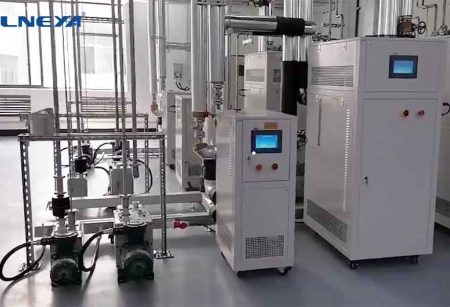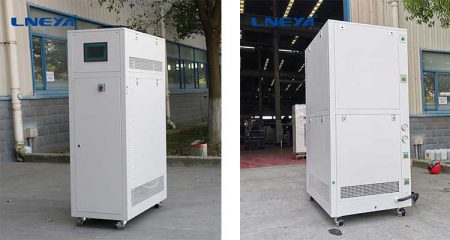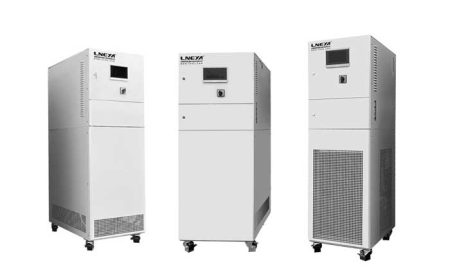Waste Heat Chiller
Contattateci oggi stesso per la soluzione di controllo della temperatura perfetta
Structure of waste heat chiller
Waste heat chiller usually consists of components such as heat exchanger, compressor, condenser, throttle valve and evaporator. Among them, the heat exchanger is the core component and is used in the refrigeration process to convert waste heat into refrigerant. The compressor compresses the low-pressure refrigerant into a high-temperature and high-pressure state, and sends it to the heat exchanger to exchange heat with the cooled waste heat. After cooling, the refrigerant enters the evaporator through the throttle valve, and absorbs heat in the evaporator to cause the surrounding medium to The temperature is reduced to achieve the purpose of refrigeration.

The principle of waste heat chiller
The refrigeration principle of waste heat chiller is based on the principle of thermodynamics, which is a refrigeration process that converts waste heat into refrigerant through a heat exchanger. When a waste heat source exists, the coolant in the heat exchanger exchanges heat with the waste heat, converting the waste heat into a refrigeration process. At the same time, the compressor compresses the low-pressure refrigerant into a high-temperature and high-pressure state, and sends it to the heat exchanger to exchange heat with the cooled waste heat. After the refrigerant is cooled, it enters the evaporator through the throttle valve, absorbs heat in the evaporator, and makes the surrounding environment cool. The temperature of the medium is reduced, thereby achieving the purpose of refrigeration.
The first step is waste heat recovery. In the industrial production process, a large amount of waste heat is often generated, which can be recovered through the waste heat recovery system. The waste heat recovery system usually consists of a waste heat exchanger, a waste heat recovery device, a waste heat storage device, etc., through which high-temperature waste heat is converted into low-temperature refrigeration.
The second step is refrigerant circulation. Refrigerant is an important part of the waste heat refrigeration system. The refrigeration effect is achieved through circulating flow. The refrigerant cycle includes four processes: evaporation, compression, condensation and expansion. During the evaporation process, the refrigerant absorbs heat from the low-temperature evaporator and becomes a gas; during the compression process, the refrigerant is compressed into a high-temperature and high-pressure gas; during the condensation process, the refrigerant dissipates heat through the condenser and becomes a liquid :During the expansion process, the refrigerant reduces the pressure through the expansion valve and becomes a low-temperature and low-pressure gas.
The third step is the cooling effect. Through waste heat recovery and refrigerant circulation, the waste heat refrigeration system can achieve cooling effects. During the refrigeration process, the refrigerant absorbs heat from the low-temperature evaporator and takes the heat away to achieve the refrigeration effect. The size of the refrigeration effect depends on factors such as the type of refrigerant, temperature and pressure.

The waste heat chiller has the following advantages:
1. Energy saving: The waste heat chiller uses waste heat for cooling without consuming additional energy.
2. Environmentally friendly: waste heat chiller does not use any harmful substances and will not produce any pollution.
3. High efficiency: The cooling efficiency of the waste heat chiller depends on the temperature and amount of the waste heat source, so it can cool efficiently.
Forniamo progettazione e produzione di sistemi di controllo della temperatura completi. Da modelli standard a prodotti completi e personalizzati fino a 900 tonnellate. Siamo specializzati nell'assistenza ai clienti e ci dedichiamo ad aiutare ogni cliente ad avere il sistema di controllo della temperatura ottimale per le sue esigenze specifiche.
Forniamo soluzioni personalizzate non standard. Sono disponibili sia chiller a raffreddamento singolo che unità combinate di raffreddamento e riscaldamento.
E-mail: info@lneya.com ID WeChat: +8615251628237 WhatsApp: +86 17851209193
Refrigeratori di raffreddamento

Refrigeratori a ricircolo / Circolatore refrigerato
Il refrigeratore può essere ampiamente utilizzato in vari settori industriali e laboratori e supporta la progettazione personalizzata.
| Intervallo di temperatura | Serie -25°C ~ +30°C | Serie -45°C ~ +30°C | Serie -60°C ~ -20°C | Serie -80°C ~ -20°C | Serie -120°C ~ -70°C | ||||
| Capacità di raffreddamento | 0,8 ~ 30kW | 0,75 ~ 12kW | 0,4 ~ 6kW | 0,2 ~ 6kW | 0,3 ~ 5kW | ||||
| Nota: qualsiasi intervallo di temperatura da -150℃ a +350℃ e qualsiasi capacità di raffreddamento possono essere personalizzati. | |||||||||
 Refrigeratori d'acqua / Piccoli refrigeratori
Refrigeratori d'acqua / Piccoli refrigeratori
Il refrigeratore può essere ampiamente utilizzato in vari settori industriali e laboratori e supporta la progettazione personalizzata.
| Intervallo di temperatura | -18°C ~ +30°C | Serie +5°C ~ +35°C | |||||||
| Capacità di raffreddamento | 0,35 ~ 0,9 kW | 1,8 ~ 50kW | |||||||
| Nota: qualsiasi intervallo di temperatura da -150℃ a +350℃ e qualsiasi capacità di raffreddamento possono essere personalizzati. | |||||||||

Refrigeratori a bassa temperatura
Siamo specializzati nella produzione di refrigeratori a bassa temperatura con un range di controllo della temperatura fino a -150°C, in grado di soddisfare le esigenze di refrigerazione di diversi settori industriali.
| Intervallo di temperatura | Serie -25°C ~ -5°C | Serie -45°C ~ -10°C | Serie -60°C ~ -10°C | Serie -80°C ~ -30°C | Serie -110°C ~ -50°C | Serie -150°C ~ -110°C | |||
| Capacità di raffreddamento | 12 ~ 360kW | 6 ~ 180kW | 6 ~ 180kW | 4 ~ 180kW | 2 ~ 120kW | 2,5 ~ 11kW | |||
| Nota: qualsiasi intervallo di temperatura da -150℃ a +350℃ e qualsiasi capacità di raffreddamento possono essere personalizzati. | |||||||||

Refrigeratori ad alta temperatura
Il refrigeratore può essere ampiamente utilizzato in vari settori industriali e laboratori e supporta la progettazione personalizzata.
| Intervallo di temperatura | +5°C ~ +40°C | -25°C ~ +40°C | -45°C ~ +40°C | -80°C ~ +80°C | -100°C ~ +80°C | ||||
| Capacità di raffreddamento | 6 ~ 40kW | 2 ~ 15kW | 1 ~ 8kW | 0,6 ~ 3kW | 1,5 ~ 3kW | ||||
| Nota: qualsiasi intervallo di temperatura da -150℃ a +350℃ e qualsiasi capacità di raffreddamento possono essere personalizzati. | |||||||||
Refrigeratori per il raffreddamento e il riscaldamento

Refrigeratori per il raffreddamento e il riscaldamento
Intervallo di controllo della temperatura: da -120°C a +350°C
termostato di raffreddamento e riscaldamento, ampiamente utilizzato in vari settori industriali.
| Intervallo di temperatura | Serie -10 ~ +150°C | Serie -25 ~ +200°C | Serie -25 ~ +300°C | Serie -45 ~ +250°C | Serie -45 ~ +300°C | Serie -60 ~ +250°C | Serie -60 ~ +300°C | Serie -70 ~ +250°C | Serie -80 ~ +250°C | Serie -90 ~ +250°C | Serie -100 ~ +100°C | ||
| Capacità di raffreddamento | 1,5 ~ 15kW | 1 ~ 200kW | 1 ~ 200kW | 0,45 ~ 200kW | 0,9 ~ 25kW | 0,25 ~ 60kW | 0,75 ~ 25kW | 0,4 ~ 15kW | 0,3 ~ 80kW | 0,2 ~ 80kW | 0,45 ~ 80kW | ||
| Nota: qualsiasi intervallo di temperatura da -150℃ a +350℃ e qualsiasi capacità di raffreddamento possono essere personalizzati. | |||||||||||||

Riscaldatori a ricircolo Refrigeratori
Intervallo di controllo della temperatura: da -45°C a +250°C
| Intervallo di temperatura | Serie -25°C ~ +200°C | Serie -45°C ~ +250°C | |||||||
| Capacità di raffreddamento | 1 ~ 15kW | 0,25 ~ 15kW | |||||||
| Nota: qualsiasi intervallo di temperatura da -150℃ a +350℃ e qualsiasi capacità di raffreddamento possono essere personalizzati. | |||||||||
 LNEYA
LNEYA
 简体中文
简体中文


















































































